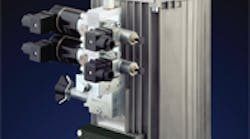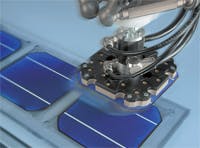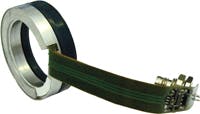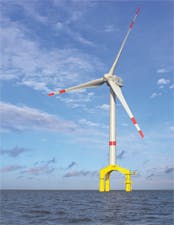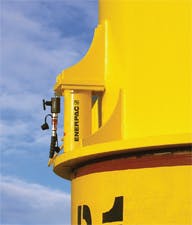Rapid growth in the manufacturing and use of alternative power-generation systems such as photovoltaic grids, solar-thermal collectors, and wind turbines is one of the few bright spots in today’s economy. But “green” electricity is more expensive than power from conventional plants, so there is an intense focus on making these systems cost competitive.
Fluid power plays an increasingly important role in manufacturing these systems and making them work with the utmost efficiency. For instance, solar-cell fab operations often prefer pneumatic handling and motion systems because they are clean, rugged, and long-lasting despite nonstop operations and exposure to harsh chemicals.
Likewise, durable hydraulics controls key systems in wind-power generators because turbines usually operate in less-than-ideal environmental conditions. Downtime can be extremely costly, both in terms of lost revenue while the turbine isn’t running and the expense of service and maintenance, especially with offshore installations. Components are also housed in cramped quarters, making the high power density of hydraulics another advantage.
Manufacturers have developed hydraulic and pneumatic components and systems with demanding needs of alternative-energy producers in mind. Here’s a look at some recent innovations.
HAWE
Unscheduled downtime in wind turbines is a leading reason why electricity generated from wind continues to cost more than that from conventional power plants. As one remedy, HAWE Hydraulics, Charlotte, N.C., recently introduced the type KA power unit specifically for use in wind turbines. It hydraulically controls yaw and rotor braking and reportedly increases the service life of costly components such as gearboxes and rotor blades. The units are compact and lightweight, install vertically or horizontally, and can mount right next to actuators, making them a good fit in the extremely tight confines of wind-tower nacelles. They can also be transported to the nacelle without a crane.
The hydraulic power unit includes a tank with an integrated submerged motor, a radial-piston or gear pump that attaches directly to the motor shaft without a coupling, and a connection block. Control modules mount directly onto the connection block and can be quickly exchanged by loosening four screws. There is no need to remove any hoses.
Steel construction lets the units withstand high pressures. The radial piston pumps supply pressurized oil up to 10,000 psi, while the valves are designed for pressures exceeding 5,800 psi. Because hydraulic pressure in wind power plants is typically below 3,600 psi, the pumps and valves operate with a high safety margin and are said to provide extremely long life.
For safety, brakes in a wind turbine must be reliable at all times. That’s why the HAWE system uses leak-free directional seated valves, according to company officials. The valves have a considerably higher switching reliability than typically found in directional spool valves, as dirt particles flush out when the valve opens. This design prevents silting that can cause spool valves to stick.
Three tank extensions on the KA provide oil volumes from two to ten liters. The power unit operates across a range of voltages, including 690 V, and is also available in a cold-climate version. HAWE offers active and passive brake control, with or without a flushing function for the brakes and brake lines. Additional modules are available for adjusting the pitch, roof openers for the turbine pod, rotor lock, and control of on-board handling cranes.
For more information, visit www.hawe.de
Parker Hannifin
The cost of operating and maintaining wind turbines continues to be one of the major challenges for the growing wind-power industry. In fact, more than 40% of downtime in wind turbines is caused by gearbox failures, often stemming from poor filtration, according to officials at Parker Hannifin, Cleveland.
While technical developments in areas such as pitch and yaw controls have had considerable impact on reducing operating costs, the logistical difficulties in carrying out regular maintenance and emergency repairs on turbines located in remote locations and, increasingly, at sea continue to have a significant impact on operating margins.
In light of these challenges, today’s wind turbines must operate both efficiently and with little manual intervention. Many turbine manufacturers are integrating the latest generation of hydraulics technology into their products — for example, reliable hydraulic pitch and yaw controls and low-maintenance hydraulic gearboxes — and it’s helping operators considerably reduce costs. But for the systems to deliver the full benefits, effective filtration and condition monitoring is a must.
Filtration is especially important to extend maintenance intervals and ensure reliability of pitch and yaw systems. Otherwise, precision-engineered components such as cylinders, accumulators, and valves can suffer from sub-par performance and premature failure, ultimately reducing wind-turbine uptime and raising costs.
Parker has developed a range of products that remove particulates and water contamination from wind-turbine hydraulic systems. For instance, one problem is hydraulic circuits in wind-turbines often rely on bypass or off-line filtration loops that clean only a small portion of the total flow, says Marco van Boven, marketing manager at Parker’s European Hydraulic Filter Div. Parker’s design, on the other hand, cleans oil in the main supply line. The company’s Microglass III media generates a low, constant pressure drop across the filter that minimizes energy losses.
It also ensures that high viscosity fluid, often found during critical cold-start conditions, is conditioned effectively. The media has good dirt-holding capacity and long life, potentially lengthening the time between service intervals. In addition, pre-filtration magnets remove ferrous particles down to sizes < 1 ∝m, helping extend filter-element life by as much as 20%.
While filtration is critical, recording and analyzing the type and amount of contamination is essential to spot problems and schedule maintenance before a component fails. However, taking samples from a hydraulic system in a wind turbine and sending them to a laboratory for testing is extremely impractical. That’s why many wind farm operators now use on-site particle counting technology.
Portable analyzers such as Parker’s Icount particle detector and LaserCM contamination monitor provide accurate, real-time measurement of contamination levels in hydraulic fluids using a light-obscuration process. Essentially, the shadow of any particles suspended in a fluid passing in front of a light source causes a voltage drop across a light-sensitive diode; the signal generated from this shadow depends on particle size and the speed at which it passes across the light.
The compact counters feature robust construction, making them suited for hostile environments typical of wind turbines. And their powerful internal computers offer consistent and accurate results, removing the subjectivity associated with manual, lab-based testing.
Condition-monitoring equipment can also be integrated into filtration systems to track lubrication cleanliness levels and water content. It’s an inexpensive way for real-time monitoring of lubricant health, while sensing and communication modules ensure an easy “plug-and-operate” linkage with the turbine SCADA systems.
For more information, visit www.parker.com.
Schmalz
Automation plays a significant role in solar-cell production, and efforts to speed and streamline manufacturing are essential to driving down costs. A typical fab operation must seamlessly integrate all process steps – particularly the loading and unloading of wafers and cells.
Manufacturers prefer vacuum grippers for handling the delicate cells, but not all grippers are equally suitable for holding, moving, positioning, stacking, and releasing photovoltaic components.
Systems for handling wafers and solar cells have tended to use conventional vacuum grippers or floating suction cups that operate based on Bernoulli’s principle. But these types of grippers have several disadvantages. Conventional grippers can produce chemical contamination and high mechanical strain at contact surfaces. Although these effects are less pronounced with floating suction cups, the cups operate at considerably lower cycle speeds, offer relatively imprecise positioning, and generate uncontrolled blow-off of nuisance particles into the process room.
Schmalz Inc., based in Raleigh, N.C., has developed a vacuum gripper for precise, non-damaging handling of highly sensitive wafers and solar cells. The SWG grips the entire surface of the wafer without leaving marks or contamination and is capable of high acceleration and process speed. For instance, systems using the SWG can operate at the much-sought-after rate of one cycle per second.
The SWG also provides accurate, reliable handling even when working with wafers smaller than the contact surface of the gripper. Because it completely extracts air and ultra-small particles, production can be carried out under clean-room conditions.
For more information, visit www.schmalz.com.
Simrit
To improve long-term availability of wind power plants – especially for off-shore installations – the Plymouth, Mich.-based Simrit Div. of Freudenberg-NOK has developed a special Simmerring sealing system. For the first time, according to the company, it provides operators with remote diagnostics for the shaft seal using built-in leakage sensors. It’s a key step in monitoring and minimizing maintenance requirements for shaft seals.
Shaft sealing rings are subject to extreme stress in wind power plants – including physical, tribological, and even chemical wear – and yet they often survive well over 10,000 hours of operation. To avoid replacing fully functional shaft sealing rings as a preventative measure, a Simmerring radial shaft seal has been developed that informs the plant operator of the state of the seal. If sealing capabilities start to deteriorate near the end of its service life, a built-in collector absorbs the ensuing leak. A sensor built into the sealing system identifies the leak and generates a signal that is then evaluated by programmable electronic controls.
After the first leak has been registered, it’s monitored and evaluated over a preset time interval. Then, the unit automatically sends a message to the operator or maintenance engineers. This lets them plan its replacement – immediately, or as part of a regular maintenance schedule without any additional downtime – depending on the severity of the leak.
Plant operators and maintenance contractors can also keep up-to-date on the condition of the sealing system by simply calling up the data at any time. This eliminates the need for the preventative replacement of seals, making it easier to plan the maintenance of wind power plants while reducing downtime and maintenance costs.
The seal with built-in leakage sensor is a modified version of the standard Simmerring and is available in two types of elastomer, NBR and FKM. If required, additional sensors – such as temperature-monitoring sensors – can be incorporated into the Simmerrings.
For more information, visit www.simrit.com.
Enerpac
Wind-turbine manufacturer Bard Engineering GmbH, Bremen, Germany, has developed a unique foundation for wind turbines. The Bard Tripile consists of a 295 ft high wind turbine that rests on three main pilings, each also 295 ft in length, that are driven 100 to 150 feet into the sea bed. Above the water surface, the pilings connect to each other by a cross piece on which the turbine mast stands.
What’s different is the mast connections are above the water surface, says Robert Ebert, deputy managing director at Bard Building GmbH. With other offshore turbines, “the mast usually rests on foundations that are below the water surface. The practical advantages are that we need fewer divers, we are less dependent on weather conditions, and it allows us to carry out maintenance much more quickly and easily,” explains Ebert.
The supporting cross piece must be level so the turbine mast is precisely plumb upright. Bard uses Enerpac’s hydraulic Synchronous Lifting System (SLS) to install the 560-ton support. Three cylinders, each operating at 10,000 psi and with a 112-ton capacity, are mounted equally spaced around each piling. So the total lifting capacity of the nine cylinders exceeds 1000 tons. The cylinders, stroke sensors, and inclinometers connect to a shipboard SLS computer and proprietary software controls the lifting process.
The cylinders first raise the supporting cross piece approximately 0.7 in. and then level it to an accuracy of 0.04 in. Once the crosspiece is level, it is locked in place with a 5-in. thick concrete casing ring, 16 ft high, poured against the interior walls of both the cross piece and piles. “Nothing is welded or bolted; the concrete casing handles all the stresses,” says Ebert. The cylinders are removed after the concrete has set.
A test wind turbine using the Bard Tripile has operated for about a year off the coast near Wilhelmshafen. The Bard Offshore 1 wind farm of 80, five-MW turbines is currently under construction in the North Sea about 60 miles north-west of the German island of Borkum.
For more information, visit enerpac.com.
Artemis
Artemis Intelligent Power Ltd, Edinburgh, Scotland, has been awarded a ≤1 million grant from the U.K.’s Dept. of Energy and Climate Change. The grant supports a program to transfer the company’s hydraulic transmission technology, originally developed for automotive use, to wind applications.
The design, which the company calls Digital Displacement, embeds proprietary computer control into proven and robust hydraulic pumps and motors. The novel software makes the machines dramatically more efficient than traditional hydraulics, while maintaining its inherent reliability, low cost, and high power density, according to company officials.
The goal is a full system demonstration in a working 1.5-MW wind turbine, with components scalable for use in larger offshore units.“Digital Displacement technology will provide cost-effective solutions to some of the most challenging engineering problems facing large-scale, offshore wind-power generation,” says Waverley Cameron, chairman of Artemis Intelligent Power. While efficiency of the hydraulic transmission is on par with that of traditional turbine gearboxes, operating and maintenance costs should be much less, says Cameron. It’s also lighter and less expensive. “Our transmission weighs about 40% and should cost about 80% of the gearbox that it will replace,” he says. “But because we can provide a variable transmission ratio, a DD turbine doesn’t need expensive and unreliable power converters and step-up transformers.” This significantly reduces the weight and cost of the nacelle and, in turn, that of the tower and foundation.
Another advantage relates to ongoing costs. Gearbox failures are one of the most costly problems with wind turbines, usually requiring two enormous truck-mounted or boat-mounted cranes, says Cameron. The DD transmission should be more reliable, he says, because traditional gearboxes transfer a huge amount of torque through just a handful of sliding-line contacts. The Artemis design, on the other hand, spreads the load among dozens of rolling contacts. “But even if there is a failure, virtually every piece can be replaced using a small crane mounted inside the nacelle,” add Cameron.
Artemis has previously demonstrated DD technology in a BMW 530i. Read details by clicking here.
